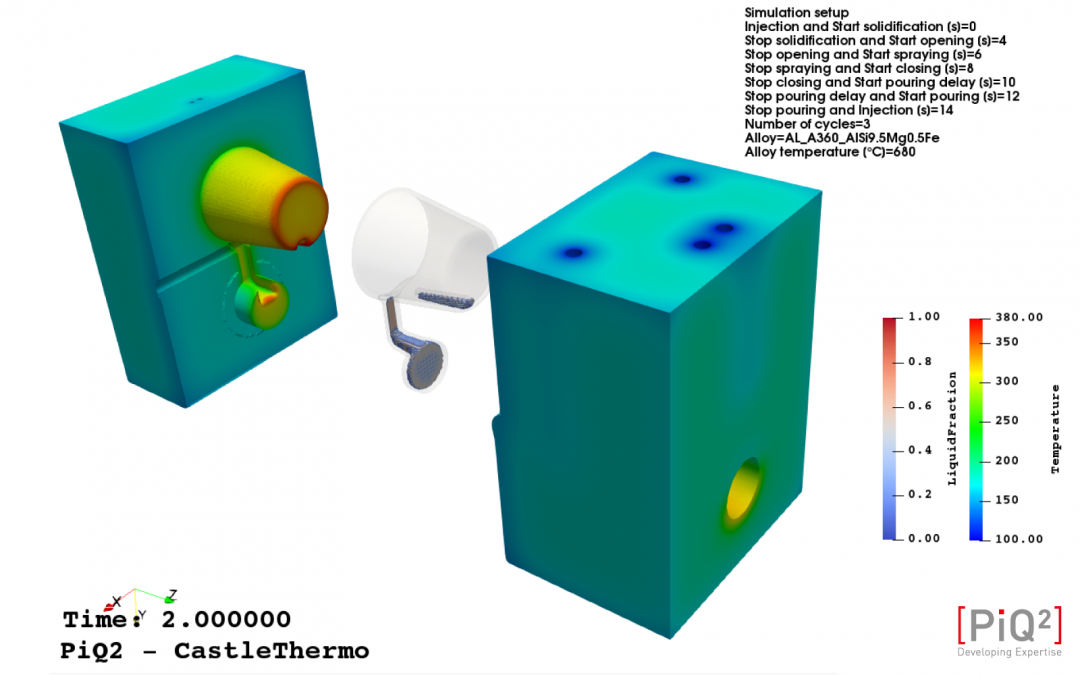The CastleTHERMO module and its functionality
CastleTHERMO evaluates the effects of the variation and distribution of temperatures in the mold on both the solidification of the casting and the life of the mold itself. For accomplishing this evaluation, the software simulates all the phenomena that affect the thermal behaviour of any die-casting mold, whether hot chamber or cold chamber, through a meticulous analysis of each micro-step within the cycle. In fact, it allows assessment of the effect of cycle time, release agent spraying, and cooling system setup (both in terms of position and size of the channels and in terms of type, temperature, and flow rate of the cooling fluid).
Since setting up a thermal analysis could be very complex, the approach of PiQ² and CastleTHERMO, in particular, is to simplify the user experience as much as possible. With CastleTHERMO, it is possible to prepare the model for meshing and set up all the parameters to run the simulation in a few minutes.
CastleTHERMO can:
- Enable an assessment of the dynamics of casting solidification by considering release agent spraying, cycle times and thermal management configuration and their influence on the formation or elimination of hot spots dealing with the formation of shrinkage porosity.
- Show the mold surface temperature distribution and variation over time and understand how it may impact casting quality.
- Analyze what happens inside the mold parts below the cavity surface. The information provided is valuable because the thermal evolution of temperature between the surface and the layers below is the main culprit for the early degradation of molds.
What’s new in the new release
PiQ², based on the users’ suggestions, has improved the previous version, in various aspects. CastleTHERMO has evolved in several aspects, both technical and functional. Let us start with the calculation aspects:
- Thanks to the new technology, the size of result files was significantly reduced by several Gigabytes. With this release, PiQ² has decreased by up to 30% compared to the previous version. Thus, disk access is faster, files are smaller, and calculation and visualization times for simulations have been reduced.
- New features have been included that allow the simulation, once finished, to be automatically moved to other disks, remote servers or the cloud. In addition to releasing valuable space on local disks, the user, at the end of the simulation, can find the results where they are most convenient for sharing or analyzing them.
- A new technology has been introduced at the computing level: SyMO (System & Memory Optimization), which can reduce and stabilize computation times by cleaning and reordering the operating system memory. That effectively optimizes and reserves computer resources for simulation computation. SyMO, launched before simulations, optimizes the operating system in a few moments by keeping the R.A.M. clean and eliminating bandwidth bottlenecks caused by Windows OS. That removes the problem of frequently occurring progressive slowdown in simulation computation speed.
In addition to the informatic improvements, many helpful functional changes have been introduced for the user, who always remains the focus of attention throughout the Castle suite:
- MESH: Mesh management has been improved, allowing the user to reload parameters from a previous mesh and change its settings without having to repeat the process from scratch.
- THERMAL MANAGEMENT: Improved and more streamlined management of the mold’s cooling channel setting. These improvements are especially useful on extremely complicated molds and with complex configurations.
- SPRAYING: Thanks to the experience gained in recent years in collaboration with several customers, the new release of CastleTHERMO has added the possibility of simulating the water-less mold spraying technology, which is rapidly establishing itself on the market. Being a lubrication not based on water but based on a practically pure product sprayed in small quantities, the effects on the mold thermal behaviour are entirely different from those of traditional technology and require particular attention.
- VIEWER: The results visualization interface has been revised to be more straightforward and intuitive, allowing the user to quickly identify the problems that arise: porosity during casting solidification.
- RESULTS: Additional results, in the form of solidification criteria, have been introduced, allowing an even more detailed evaluation, and facilitating the interpretation of the results.
It is precisely for these pluses that the Castle suite can satisfy its customers’ needs, innovating starting from direct requests and resulting in reliable and feature-rich support. Would you like to discover more tips, or would you like more information?

